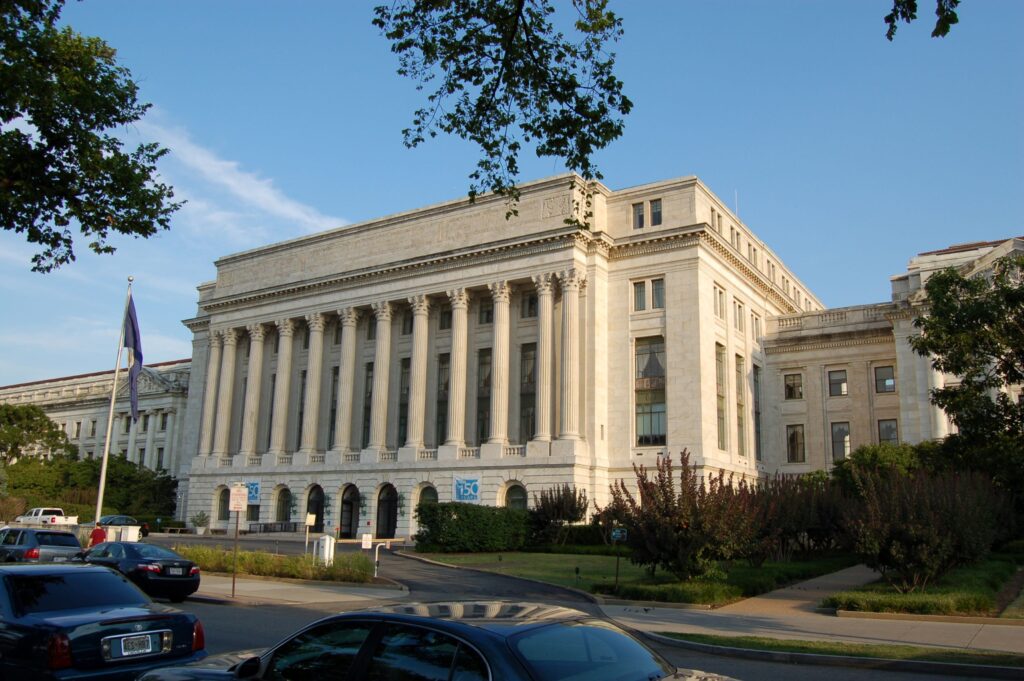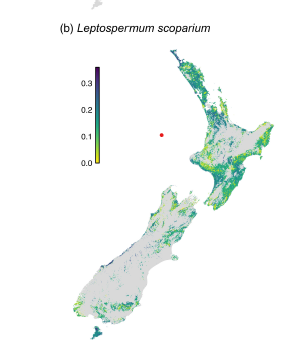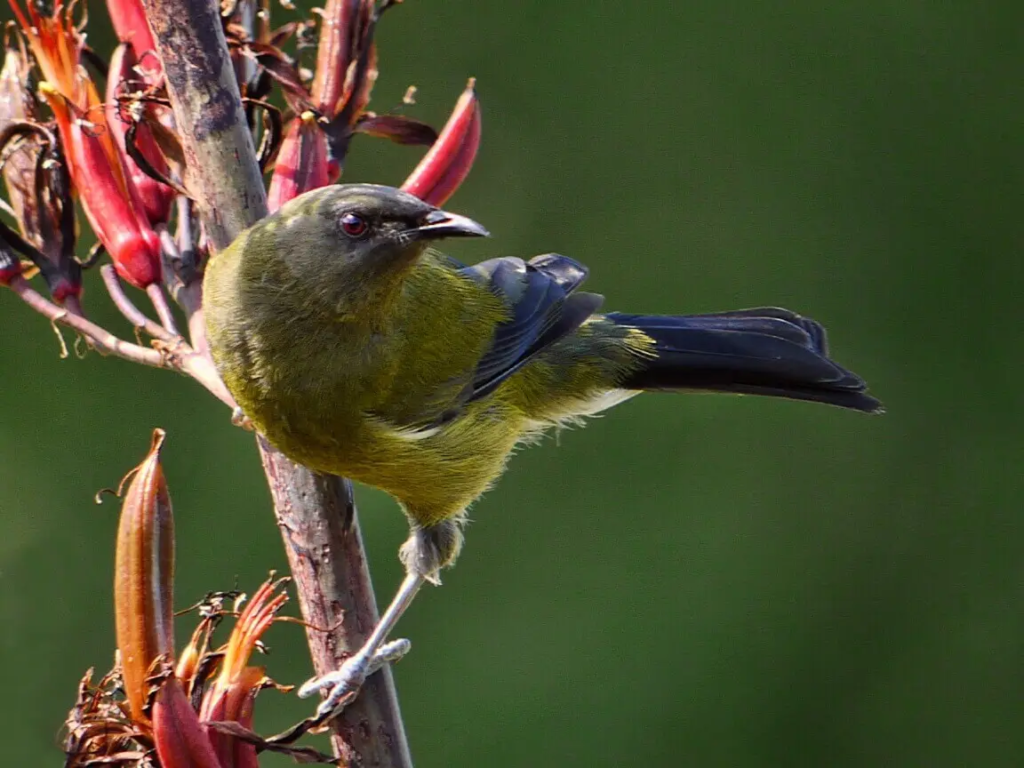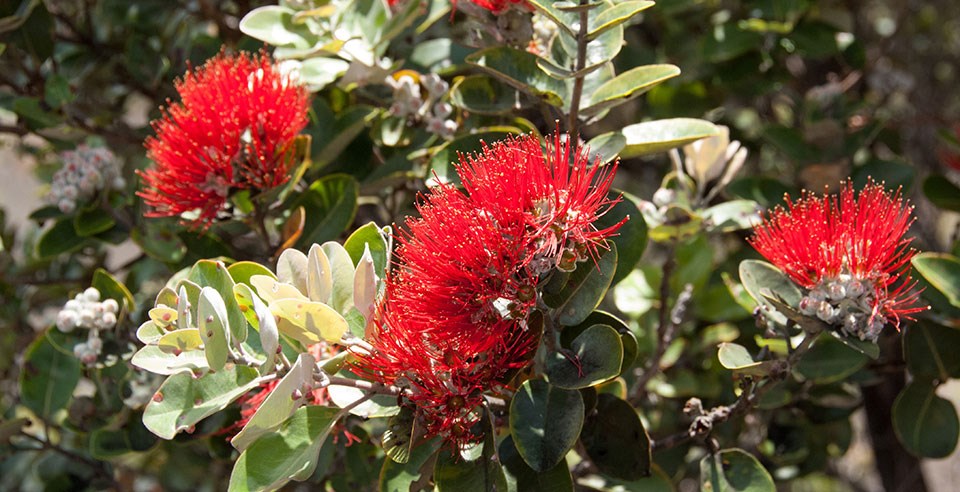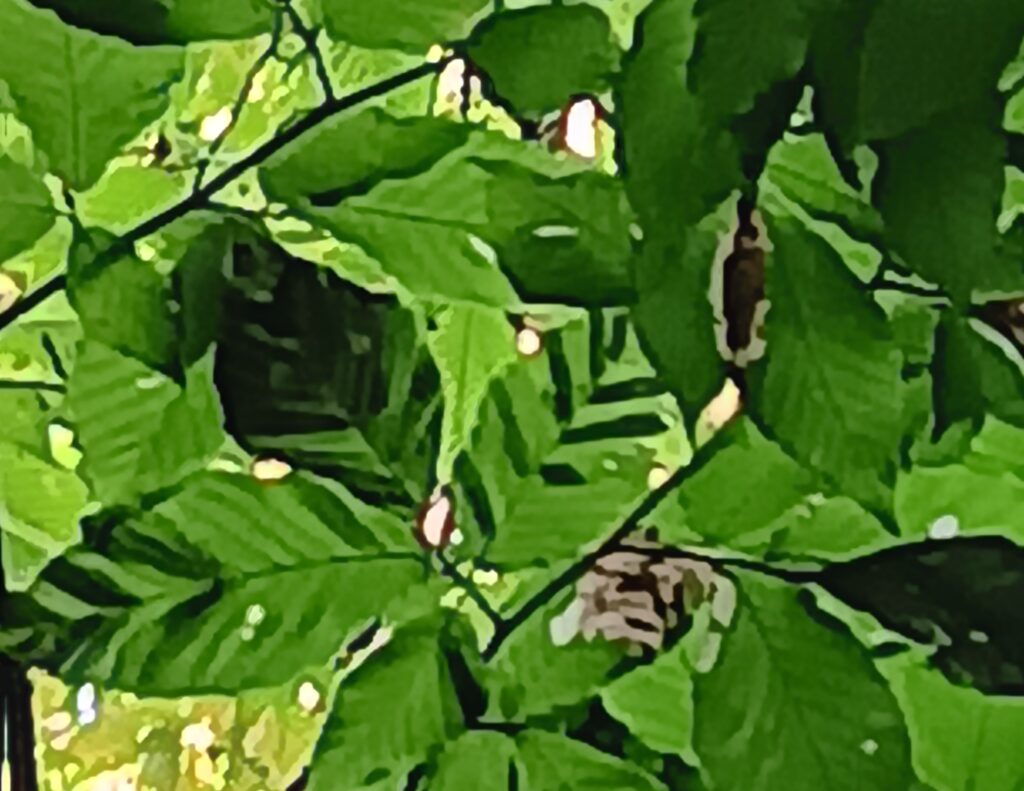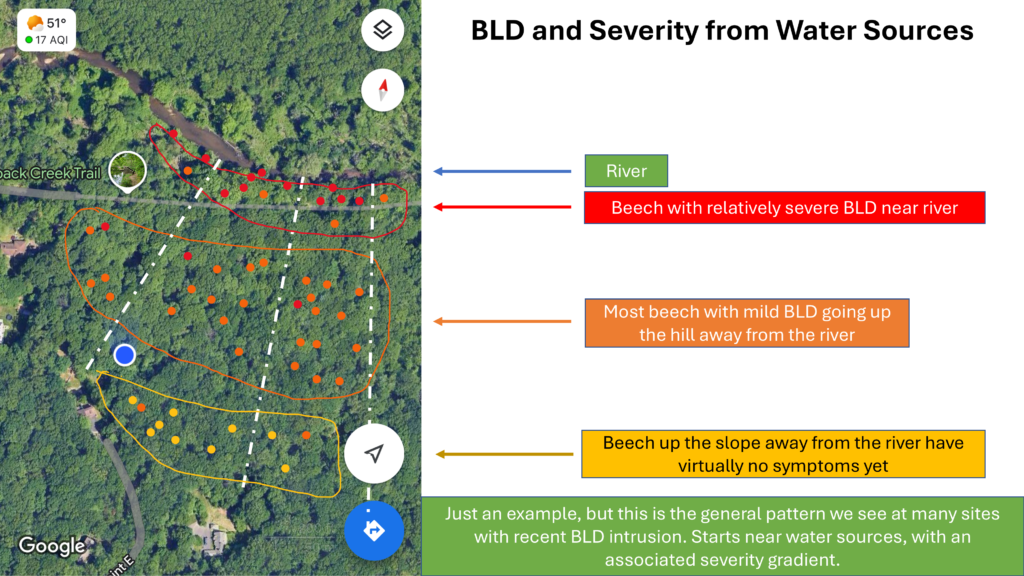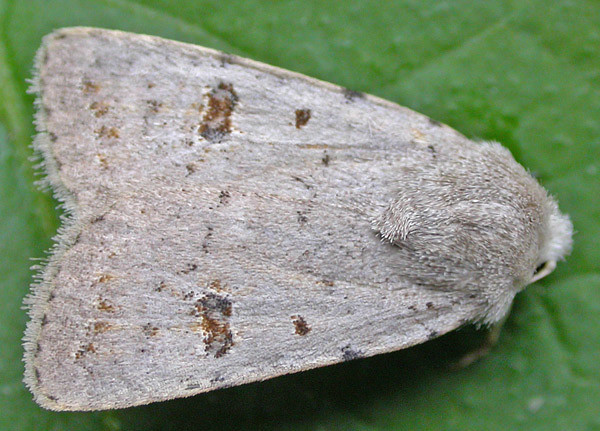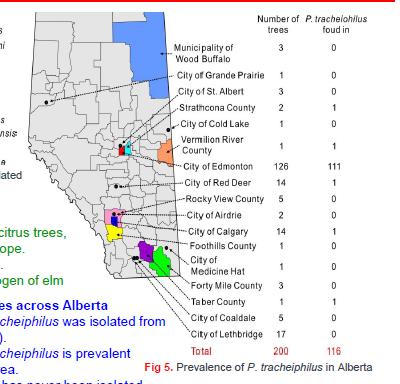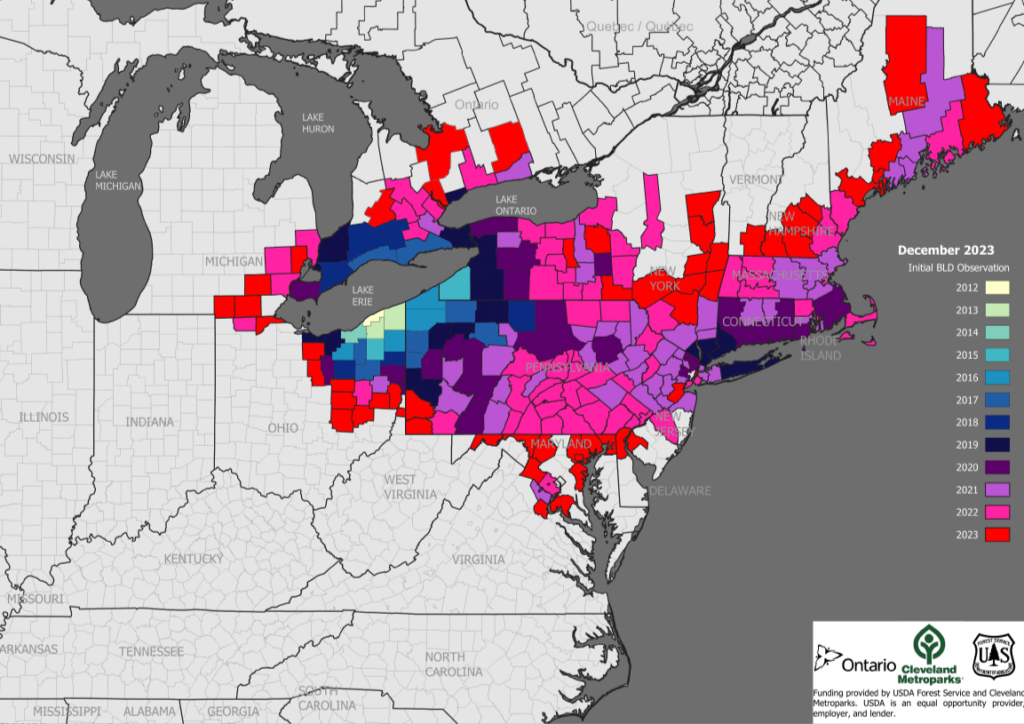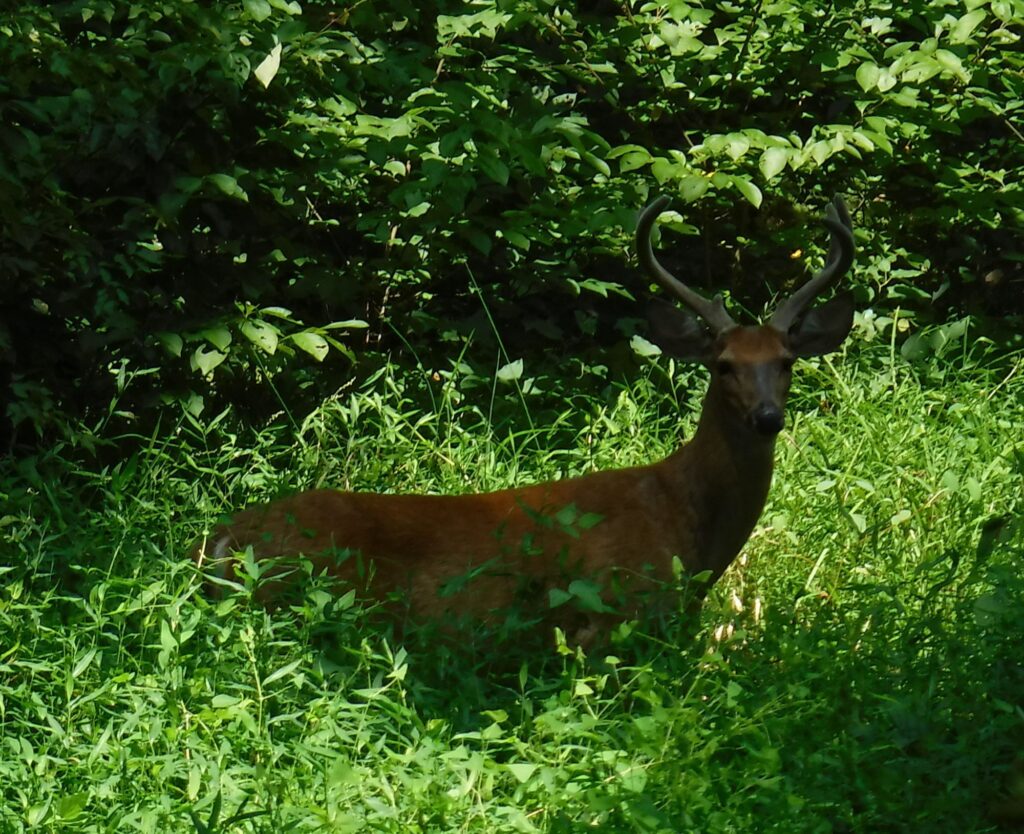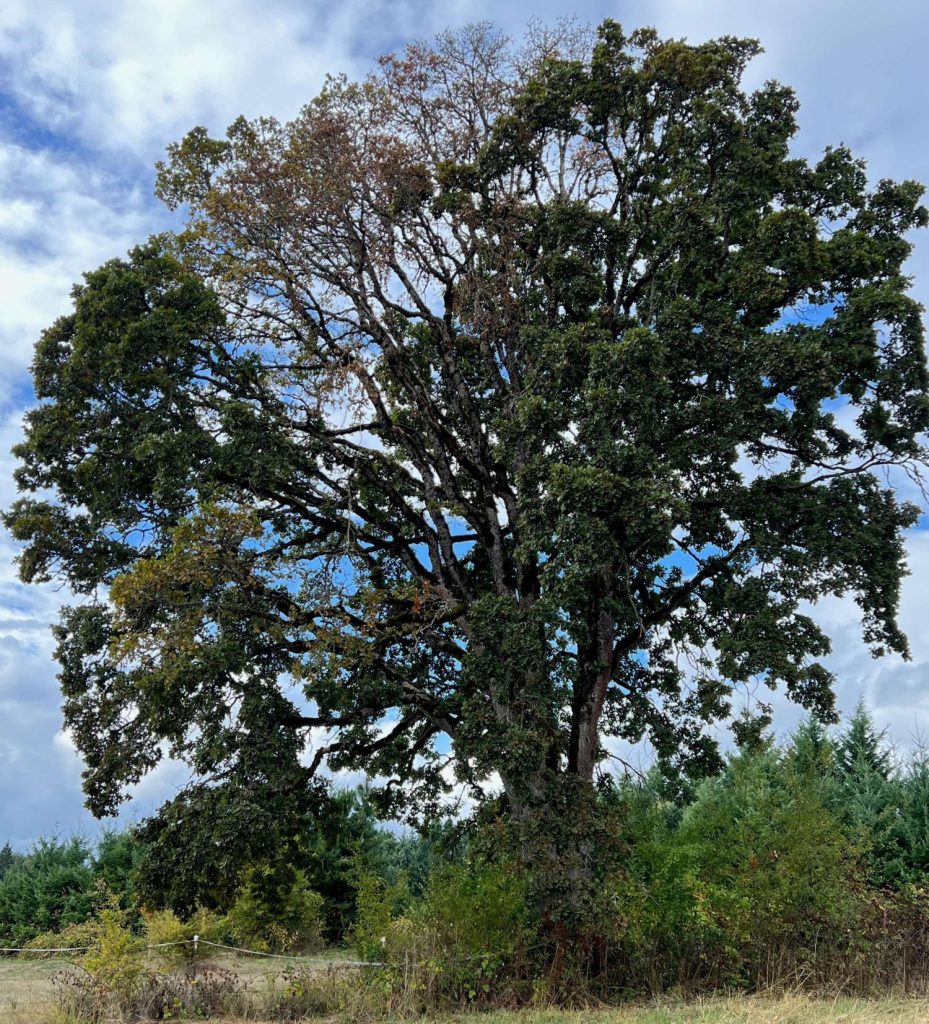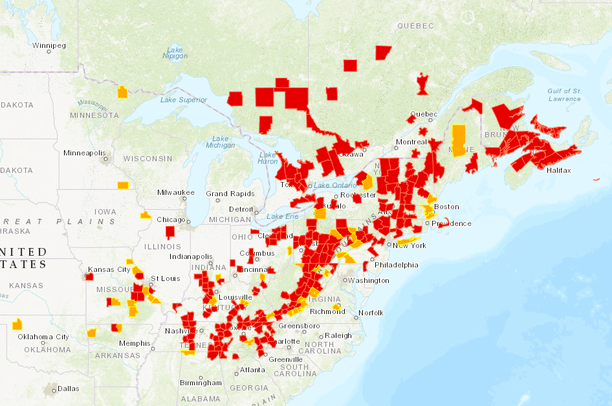Several Hawaiian tree species are at risk due to introduced forest pests. Two of the Islands’ most widespread species are among the at-risk taxa. Their continuing loss would expose watersheds on which human life and agriculture depend. Habitats for hundreds of other species – many endemic and already endangered – would lose their foundations. These trees also are of the greatest cultural importance to Native Hawaiians.
I am pleased to report that Hawaiian scientists and conservationists are trying to protect and restore them.
Other tree species enjoy less recognition … and efforts to protect them have struggled to obtain support.
1) koa (Acacia koa)
Koa is both a dominant canopy tree and the second-most abundant native tree species in Hawai`i in terms of areas covered. The species is endemic to the Hawaiian archipelago. Koa forests provide habitat for 30 of the islands’ remaining 35 native bird species, many of which are listed under the U.S. Endangered Species Act. Also dependent on koa forests are native plant and invertebrate species and the Islands’ only native terrestrial mammal, the Hawaiian hoary bat. Finally, koa forests protect watersheds, add nitrogen to degraded soils, and store carbon [Inman-Narahari et al.]
Koa forests once ranged from near sea level to above 7000 ft (2100 m) on both the wet and dry sides of all the large Hawaiian Islands. Conversion of forests to livestock grazing and row-crop agriculture has reduced koa’s range. Significant koa forests are now found on four islands – Hawai’i, Maui, O‘ahu, and Kauaʻi. More than 90% of the remaining koa forests occur on Hawai`i Island (the “Big Island) [Inman-Narahari et al.]
In addition to its fundamental environmental role, koa has immense cultural importance. Koa represents strength and the warrior spirit. The wood was used traditionally to make sea-going canoes. Now Koa is widely used for making musical instruments, especially guitars and ukuleles; furniture, surfboards, ornaments, and art [Inman-Narahari et al.]
Koa timber has the highest monetary value of any wood harvested on the Islands. However, supplies of commercial-quality trees are very limited (Dudley et al. 2020). Harvesting is entirely from old-growth forests on private land. [Inman-Narahari et al.]
Koa forests are under threat by a vascular wilt disease caused by Fusarium oxysporum f. sp. koae (FOXY). This disease can kill up to 90% of young trees and – sometimes — mature trees in native forests. The fungus is a soil-dwelling organism that spreads in soil and infects susceptible plants through the root system (Dudley et al. 2020).
Conservation and commercial considerations have converged to prompt efforts to breed koa resistant to FOXY. Conservationists hope to restore native forests on large areas where agriculture has declined. The forestry industry seeks to enhance supplies of the Islands’ most valuable wood. Finally, science indicated that a breeding program would probably be successful. Field trials in the 1990s demonstrated great differences in wilt-disease mortality among seed sources (the proportion of seedlings surviving inoculation ranged from 4% to 91.6%) [Sniezko 2003; Dudley et al. 2009].
In 2003, Dudley and Sniezko outlined a long-term strategy for exploring and utilizing genetic resistance in koa. Since then, a team of scientists and foresters has implemented different phases of the strategy and refined it further (Dudley et al. 2012, 2015, 2017; Sniezko et al. 2016]
First, scientists determined that the wilt disease is established on the four main islands. Having obtained more than 500 isolates of the pathogen from 386 trees sampled at 46 sites, scientists tested more than 700 koa families from 11 ecoregions for resistance against ten of the most highly virulent isolates (Dudley et al. 2020).
The Hawaiian Agricultural Research Center (HARC), supported by public and private partners, has converted the field-testing facilities on Hawai`i, Maui, and Oahu into seed orchards. The best-performing tree families are being grown to maturity to produce seeds for planting. It is essential that the seedlings be not just resistant to FOXY but also adapted to the ecological conditions of the specific site where they are to be planted [Dudley et al. 2020; Inman-Narahari et al. ] Locally adapted, wilt-resistant seed has been planted on Kauaʻi and Hawai`i. Preparations are being made to plant seed on Maui and O‘ahu also. Scientists are also exploring methods to scale up planting in both restoration and commercial forests [R. Hauff pers. comm.].
Restoration of koa on the approximately half of lands in the species’ former range that are privately owned will require that the trees provide superior timber. Private landowners might also need financial incentives since the rotation time for a koa plantation is thought to be 30-80 years. [Inman-Narahari et al.]
Plantings on both private and public lands will need to be protected from grazing by feral ungulates and encroachment by competing plants. These management actions are intensive, expensive, and must be maintained for years.
Some additional challenges are scientific: uncertainties about appropriate seed zones, efficacy of silvicultural approaches to managing the disease, and whether koa can be managed for sustainable harvests. Human considerations are also important: Hawai`i lacks sufficient professional tree improvement or silvicultural personnel, a functioning seed distribution and banking network — and supporting resources. Finally, some segments of the public oppose ungulate control programs. Inman-Narahari et al.
Finally, scientists must monitor seed orchards and field plantings for any signs of maladaptation to climate change. (Dudley et al. 2020).
2) ʻŌhiʻa Metrosideros polymorpha)
ʻŌhiʻa lehua is the most widespread tree on the Islands. It dominates approximately 80% the biomass of Hawaii’s remaining native forest, in both wet and dry habitats. ʻŌhiʻa illustrates adaptive radiation and appears to be undergoing incipient speciation. The multitude of ecological niches and their isolation on the separate islands has resulted in five recognized species in the genus Metrosideros. Even the species found throughout the state, Metrosideros polymorpha, has eight recognized varieties (Luiz et al. (2023) (some authorities say there are more).
Loss of this iconic species could result in significant changes to the structure, composition, and potentially, the function, of forests on a landscape level. High elevation ‘ohi‘a forests protect watersheds across the state. ʻŌhiʻa forests shelter the Islands’ one native terrestrial mammal (Hawaiian hoary bat), 30 species of forest birds, and more than 500 endemic arthropod species. Many species in all these taxa are endangered or threatened (Luiz et al. 2023). The increased light penetrating interior forests following canopy dieback facilitates invasion by light-loving non-native plant species, of which Hawai`i has dozens. There is perhaps no other species in the United States that supports more endangered taxa or that plays such a geographical dominant ecological keystone role [Luiz et al. 2023]
For many Native Hawaiians, ‘ōhi‘a is a physical manifestation of multiple Hawaiian deities and the subject of many Hawaiian proverbs, chants, and stories; and foundational to the scared practice of many hula. The wood has numerous uses. Flowers, shoots, and aerial roots are used medicinally and for making lei. The importance of the biocultural link between ‘ōhi‘a and the people of Hawai`i is described by Loope and LaRosa (2008) and Luiz et al. (2023).
In 2010 scientists detected rapid mortality affecting ‘ōhi‘a on Hawai‘i Island. Scientists determined that the disease is caused by two recently-described pathogenic fungi, Ceratocystis lukuohia and Ceratocystis huliohia. The two diseases, Ceratocystis wilt and Ceratocystis canker of ʻōhiʻa, are jointly called “rapid ‘ōhi‘a death”, or ROD. The more virulent species, C. lukuohia, has since spread across Hawai`i Island and been detected on Kaua‘i. The less virulent C. huliohia is established on Hawai`i and Kaua‘i and in about a dozen trees on O‘ahu. One tree on Maui was infected; it was destroyed, and no new infection has been detected [M. Hughes pers. comm.] As of 2023, significant mortality has occurred on more than one third of the vulnerable forest on Hawai`i Island, although mortality is patchy.
[ʻŌhiʻa is also facing a separate disease called myrtle rust caused by the fungus Austropuccinia psidii; to date this rust has caused less virulent infections on ‘ōhi‘a.]
Because of the ecological importance of ‘ōhi‘a and the rapid spread of these lethal diseases, research into possible resistance to the more virulent pathogen, C. lukiohia began fairly quickly, in 2016. Some ‘ōhi‘a survive in forests on the Big Island in the presence of ROD, raising hopes that some trees might possess natural resistance. Scientists are collecting germplasm from these lightly impacted stands near high-mortality stands (Luiz et al. 2023). Five seedlings representing four varieties of M. polymorpha that survived several years’ exposure to the disease are being used to produce rooted cuttings and seeds for further evaluation of these genotypes.
Encouraged by these developments, and recognizing the scope of additional work needed, in 2018 stakeholders created a collaborative partnership that includes state, federal, and non-profit agencies and entities, ʻŌhiʻa Disease Resistance Program (‘ODRP) (Luiz et al. 2023). The partnership seeks to provide baseline information on genetic resistance present in all Hawaiian taxa in the genus Metrosideros. It aims further to develop sources of ROD-resistant germplasm for restoration intended to serve several purposes: cultural plantings, landscaping, and ecological restoration. ‘ODRP is pursuing screenings of seedlings and rooted cuttings sampled from native Metrosideros throughout Hawai`i while trying to improve screening and growing methods. Progress will depend on expanding these efforts to include field trials; research into environmental and genetic drivers of susceptibility and resistance; developing remote sensing and molecular methods to rapidly detect ROD-resistant individuals; and support already ongoing Metrosideros conservation. If levels of resistance in wild populations prove to be insufficient, the program will also undertake breeding (Luiz et al. 2023).
To be successful, ‘ODRP must surmount several challenges (Luiz et al. 2022):
- increase capacity to screen seedlings from several hundred plants per year to several thousand;
- optimize artificial inoculation methodologies;
- determine the effects of temperature and season on infection rates and disease progression;
- find ways to speed up seedlings’ attaining sufficient size for testing;
- develop improved ways to propagate ʻōhiʻa from seed and rooted cuttings;
- establish sites for field testing of putatively resistant trees across a wide range of climatic and edaphic conditions;
- establish seed orchard, preferably on several islands;
- establish systems for seed collection from the wide variety of subspecies/varieties;
- if breeding to enhance resistance is appropriate, it will be useful to develop high-throughput phenotyping of the seed orchard plantings.
[See DMF profile for more details.]
Developing ROD-resistant ‘ōhi‘a is only one part of a holistic conservation program. Luiz et al. (2023) reiterate the importance of quarantines and education to curtail movement of infected material and countering activities that injure the trees. Fencing to protect these forests from grazing by feral animals can drastically reduce the amount of disease. Finally, scientists must overcome the factors there caused the almost complete lack of natural regeneration of ‘ōhi‘a in lower elevation forests. Most important are competition by invasive plants, predation by feral ungulates, and the presence of other diseases, e.g., Austropuccinia psidii.
Hawaii’s dryland forests are highly endangered: more than 90% of dry forests are already lost due to habitat destruction and the spread of invasive plant and animal species. Two tree species are the focus of species-specific programs aimed at restoring them to remaining dryland forests. However, support for both programs seems precarious and requires stable long-term funding; disease resistance programs often necessitate decades-long endeavors.
1) naio (Myoporum sandwicense)
Naio grows on all of the main Hawaiian Islands at elevations ranging from sea level to 3000 m. While it occurs in the full range of forest types from dry to wet, naio is one of two tree species that dominate upland dry forests. The other species is mamane, Sophora chrysophylla. Naio is a key forage tree for two endangered honeycreepers, palila (Loxioides bailleui) and `akiapola`au (Hemignathus munroi). The tree is also an important host of many species of native yellow-face bees (Hylaeus spp). Finally, loss of a native tree species in priority watersheds might lead to invasions by non-native plants that consume more water or increase runoff.
The invasive non-native Myoporum thrips, Klambothrips myopori, was detected on Hawai‘i Island in December 2008 (L. Kaufman website). In 2018 the thrips was found also on Oahu (work plan). The Myoporum thrips feeds on and causes galls on plants’ terminal growth. This can eventually lead to death of the plant.
Aware of thrips-caused death of plants in the Myoporum genus in California, the Hawaii Department of Lands and Natural Resources Division of Forestry and Wildlife and the University of Hawai‘i began efforts to determine the insect’s distribution and infestation rates, as well as the overall health of naio populations on the Big Island. This initiative began in September 2010, nearly two years after the thrips’ detection. Scientists monitored nine protected natural habitats for four years. This monitoring program was supported by the USFS Forest Health Protection program. This program is described by Kaufman.
The monitoring program determined that by 2013, the thrips has spread across most of Hawi`i Island, on its own and aided by human movement of landscaping plants. More than 60% of trees being monitored had died. Infestation and dieback levels had both increased, especially at medium elevation sites. The authors feared that mortality at high elevations would increase in the future. They found no evidence that natural enemies are effective controlling naio thrips populations on Hawai`i Island.
Kaufman was skeptical that biological control would be effective. She suggested, instead, a breeding program, including hybridizing M. sandwicensis with non-Hawaiian Myoporum species that appear to be resistant to thrips. Kaufman also called for additional programs: active monitoring to prevent thrips from establishing on neighboring islands; and collection and storage of naio seeds.
Ten years later, in February 2024, DLNR Division of Forestry and Wildlife adopted a draft work plan for exploring possible resistance to the Myoporum thrips. Early steps include establishing a database to record data needed to track parent trees, associated propagules, and the results of tests. These data are crucial to keeping track of which trees show the most promise. Other actions will aim to hone methods and processes. Among practical questions to be answered are a) whether scientists can grow even-aged stands of naio seedlings; b) identifying the most efficient resistance screening techniques; and c) whether K. myopori thrips are naturally present in sufficient numbers to be used in tests, or – alternatively – whether they must be augmented. [Plan]
Meanwhile, scientists have begun collecting seed from unaffected or lightly affected naio in hotspots where mortality is high. They have focused on the dry and mesic forests of the western side of Hawai`i (“Big”) Island, where the largest number of naio populations still occur and are at high risk. Unfortunately, these “lingering” trees remain vulnerable to other threats, such as browsing by feral ungulates, competition with invasive plants, drought, and reduced fecundity & regeneration.
Hawai`i DLNR has secured initial funding from the Department of Defense’s REPI program to begin a pest resistance project and is seeking a partnership with University of Hawai`i to carry out tests “challenging” different naio families’ resistance to the thrips [R. Hauff pers. comm.]
2) wiliwili (Erythrina sandwicensis)
Efforts to protect the wiliwili have focused on biological control. The introduced Erythrina gall wasp, Quadrastichus erythrinae (EGW) was detected on the islands in 2005. It immediately caused considerable damage to the native tree and cultivated nonnative coral trees.
A parasitic wasp, Eurytoma erythrinae, was approved for release in November 2008 – only 3 ½ years after EGW was detected on O‘ahu. The parasitic wasp quickly suppressed the gall wasp’s impacts to both wiliwili trees and non-native Erythrina. By 2024, managers are once again planting the tree in restoration projects.
However, both the gall wasp and a second insect pest – a bruchid, Specularius impressithorax – can cause loss of more than 75% of the seed crop. This damage means that the tree cannot regenerate. By 2019, Hawaiian authorities began seeking permission to release a second biocontrol gent, Aprostocitus nites.Unfortunately, the Hawai’i Department of Agriculture still has not approved the release permit despite five years having passed. Once they have this approval, the scientists will then need to ask USDA Animal and Plant Health Inspection Service (APHIS) for its approval [R. Hauff, pers. comm.]
SOURCES
www.RapidOhiaDeath.org
Dudley, N., R. James, R. Sniezko, P. Cannon, A. Yeh, T. Jones, & Michael Kaufmann. 2009? Operational Disease Screening Program for Resistance to Wilt in Acacia koa in Hawai`i. Hawai`i Forestry Association Newsletter August 29 2009
Dudley, N., T. Jones, K. Gerber, A.L. Ross-Davis, R.A. Sniezko, P. Cannon & J. Dobbs. 2020. Establishment of a Genetically Diverse, Disease-Resistant Acacia koa Seed Orchard in Kokee, Kauai: Early Growth, Form, & Survival. Forests 2020, 11, 1276; doi:10.3390/f11121276 www.mdpi.com/journal/forests
Friday, J. B., L. Keith, and F. Hughes. 2015. Rapid ʻŌhiʻa Death (Ceratocystis Wilt of ʻŌhiʻa). PD-107, College of Tropical Agriculture and Human Resources, University of Hawai‘i, Honolulu, HI. URL: https://www.ctahr.HI.edu/oc/freepubs/pdf/PD-107.pdf Accessed April 3, 2018.
Friday, J.B. 2018. Rapid ??hi?a Death Symposium -West Hawai`i (“West Side Symposium”) March 3rd 2018, https://vimeo.com/258704469 Accessed April 4, 2018 (see also full video archive at https://vimeo.com/user10051674)
Inman-Narahari, F., R. Hauff, S.S. Mann, I. Sprecher, & L. Hadway. Koa Action Plan: Management & research priorities for Acacia koa forestry in Hawai`i. State of Hawai`i Department of Land & Natural Resources Division of Forestry & Wildlife no date
Kaufman, L.V, J. Yalemar, M.G. Wright. In press. Classical biological control of the erythrina gall wasp, Quadrastichus erythrinae, in Hawaii: Conserving an endangered habitat. Biological Control. Vol. 142, March 2020
Loope, L. and A.M. LaRosa. 2008. ‘Ohi’a Rust (Eucalyptus Rust) (Puccinia psidii Winter) Risk Assessment for Hawai‘i.
Luiz, B.C. 2017. Understanding Ceratocystis. sp A: Growth, morphology, and host resistance. MS thesis, University of Hawai‘i at Hilo.
Luiz, B.C., C.P. Giardina, L.M. Keith, D.F. Jacobs, R.A. Sniezko, M.A. Hughes, J.B. Friday, P. Cannon, R. Hauff, K. Francisco, M.M. Chau, N. Dudley, A. Yeh, G. Asner, R.E. Martin, R. Perroy, B.J. Tucker, A. Evangelista, V. Fernandez, C. Martins-Keli’iho.omalu, K. Santos, R. Ohara. 2023. A framework for establishlishing a rapid ‘Ohi‘a death resistance program New Forests 54, 637–660. https://doi.org/10.1007/s11056-021-09896-5
Additional information on the koa resistance program is posted at http://www.harc-hspa.com/forestry.html
Sniezko, R.A., N. Dudley, T. Jones, & P. Cannon. 2016. Koa wilt resistance & koa genetics – key to successful restoration & reforestation of koa (Acacia koa). Acacia koa in Hawai‘i: Facing the Future. Proceedings of the 2016 Symposium, Hilo, HI: www.TropHTIRC.org , www.ctahr.HI.edu/forestry
Posted by Faith Campbell
We welcome comments that supplement or correct factual information, suggest new approaches, or promote thoughtful consideration. We post comments that disagree with us — but not those we judge to be not civil or inflammatory.
For a detailed discussion of the policies and practices that have allowed these pests to enter and spread – and that do not promote effective restoration strategies – review the Fading Forests report at https://treeimprovement.tennessee.edu/
or












